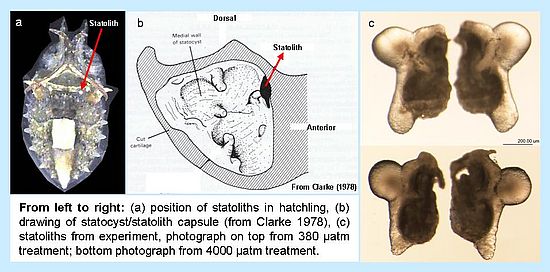Cuttlefish and ocean acidification
Impact of elevated seawater pCO2 concentration on statolith morphology and prey capture ability in early life cuttlefish, Sepia officinalis
Early life cuttlefish were reared at 15°C and 35 psu in a flow-through artificial seawater system under three pCO2 conditions, 700 µatm (control), 1400 µatm, and 4000 µatm during 63 days. Statoliths of both, embryonic and hatchling cuttlefish raised under 4000 µatm showed a modified morphology and deformed microstructural characteristics, whereas those grown under control and 1400 µatm did not. The statolith morphometrics that showed the most remarkable changes were total statolith length, rostrum transects, wing area and statolith weight. Statolith microstructure was significantly affected by irregularly arranged statoconia, which were typical in the statolith wing area, replacing the highly compact and well arranged crystals of rostrum and spur in normal growing statoliths (control). This abnormal crystal structure can have profound effects on statolith density and consequently on its normal functioning as a tool for detecting acceleration and movement. At 4000 µatm cuttlefish showed a reduced ability to capture prey and were not able to successfully launch attacks against prey organisms.
In order to certify these observations, a second experiment was conducted over 85 days under natural seawater conditions. Statolith morphology and microstructure differed again in the 4000 µatm group, with enhanced hypercalcification of the statoliths from the experiments exposed to elevated pCO2 (see photographs below). On the other hand, prey capture ability of the hatchlings showed recovery in the course of the experiment, indicating a possible acclimation (Maneja et al., 2011; in prep.).
This research has been funded by CalMarO (Calcification by Marine Organisms). CalMarO is a European Initial Training Network that aims at improving the career perspectives of early researchers by offering structured training in the field of calcification by marine organisms as well as providing complementary skills and exposing the researchers to other sectors including private companies. The project has been performed in close collaboration with the Department of Biology, University of Bergen, Norway (Dr. Audrey J Geffen).
Maneja RH, Piatkowski U, Melzner F (2011) Effects of ocean acidification on statolith calcification and prey capture in early life cuttlefish, Sepia officinalis. J Shellfish Res 30:1011
back



